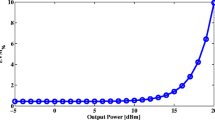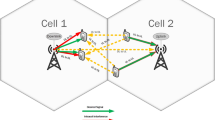Abstract
The rise in wireless data traffic requires innovative interference management techniques to meet the demand. Transmit cooperation among multiple base stations has been proposed as a solution to this challenge and improve throughput. This paper proposes novel resource allocation algorithms with two different cooperation paradigms, viz. the cooperative beamforming and partial data cooperation. The well-known duality principle, which has been used to solve uplink and downlink optimisation problems in previous literature, is shown to exist for multicell systems with both coordinated beamforming and the novel paradigm termed as partial data cooperation. Using the generalised version of duality, this paper solves relevant resource allocation problems in both cases. The proposed power allocation problems are shown to outperform some of the existing optimisation techniques in terms of throughput while having significant conceptual and theoretical advantage.





Similar content being viewed by others
Notes
Analyses of full duplex communication requires modelling of the self-interference [9], which is not within the scope of this work.
For broadcast systems, the channel vector is a column, hence the Hermitian is multiplied with the transmit column vector to obtain a scalar.
This is different from the complexity of encoding/decoding the bits using DPC.
For notational convenience, in PDC schemes we denote the total number of UE by J, unlike the CBF case.
This is in contrast with Algorithm 1, where the problems are solved parallely and solutions are independent.
References
Marzetta, T. L. (2010). Noncooperative cellular wireless with unlimited numbers of base station antennas. IEEE Transactions on Wireless Communications, 9(11), 3590–3600.
Chae, C. B., Hwang, I., Heath, R. W., & Tarokh, V. (2012). Interference aware-coordinated beamforming in a multi-cell system. IEEE Transactions on Wireless Communications, 11(10), 3692–3703.
Li, Y., Bai, L., Chen, C., Jin, Y., & Choi, J. (2013). Successive orthogonal beamforming for cooperative multi-point downlinks. IET Communications, 7(8), 706–714.
He, S., Huang, Y., Yang, L., Nallanathan, A., & Liu, P. (2012). A multi-cell beamforming design by uplink-downlink max–min SINR duality. IEEE Transactions on Wireless Communications, 11(8), 2858–2867.
Dartmann, G., Gong, X., Afzal, W., & Ascheid, G. (2013). On the duality of the max–min beamforming problemwith per-antenna and per-antenna-array power. IEEE Transactions on Vehicular Technology, 62(2), 606–619.
Nguyen, D. H. N., & Le-Ngoc, T. (2014). Sum-rate maximization in the multicell MIMO multiple-access channel with interference coordination. IEEE Transactions on Wireless Communications, 13(1), 36–48.
Vishwanath, S., Jindal, N., & Goldsmith, A. J. (2003). Duality, achievable rates, and sum-rate capacity of Gaussian MIMO broadcast channels. IEEE Transactions on Information Theory, 49(10), 2658–2668.
Zhang, L., Zhang, R., Liang, Y. C., Xin, Y., & Vincent Poor, H. (2012). On Gaussian MIMO BC-MAC duality with multiple transmit covariance constraints. IEEE Transactions on Information Theory, 58(4), 2064–2078.
Kim, S. M., & Bengtsson, M. (2016). Virtual full-duplex buffer-aided relaying in the presence of inter-relay interference. IEEE Transactions on Wireless Communications, 15(4), 2966–2980.
Hwang, I., Chae, C. B., Lee, J., & Heath, R. W. (2013). Multicell cooperative systems with multiple receive antennas. IEEE Wireless Communications, 20(1), 50–58.
Caire, G., & Shitz, S. S. (2003). On the achievable throughput of a multiantenna Gaussian broadcast channel. IEEE Transactions on Information Theory, 49(7), 1691–1706.
Kießling, M. (2004). Statistical analysis and transmit prefiltering for MIMO wireless systems in correlated fading environments. PhD thesis, Universität Stuttgart.
Hoffman, K., & Kunze, R. (2001). Linear algebra (2nd ed.). New Jersey: Pearson Education Inc.
Roy, S. B., & Madhukumar, A. S. (2015). Characterising the Pareto frontier of multiple access rate region. Springer Journal of Wireless Networks, 21(5), 1537–1548.
Zanella, A., Chiani, M., & Win, M. Z. (2005). MMSE reception and successive interference cancellation for MIMO systems with high spectral efficiency. IEEE Transactions on Wireless Communications, 4(3), 1244–1253.
Schubert, M., & Boche, H. (2007). A generic approach to QoS-based transceiver optimization. IEEE Transactions on Communications, 55(8), 1557–1566.
Barman Roy, S., Madhukumar, A. S., & Joung, J. (2017). On joint pareto frontier in multiple access and relay rate regions with Rayleigh fading. IEEE Transactions on Vehicular Technology, 66(5), 3777–3786.
Berry, M. W. (1992). Large scale singular value computations. International Journal of Supercomputer Applications, 6(1), 13–49.
You, L., Gao, X., Swindlehurst, A. L., & Zhong, W. (2016). Channel acquisition for massive MIMO-OFDM with adjustable phase shift pilots. IEEE Transactions on Signal Processing, 64(6), 1461–1476.
Colemanm, T. F., & Pothen, A. (1987). The null space problem II: Algorithms. Journal on Algebraic Discrete Methods, 8(4), 544–563.
Annapureddy, V. S., & Veeravalli, V. V. (2009). Gaussian interference networks: Sum capacity in the low interference regime and new outer bounds on the capacity region. IEEE Transactions on Information Theory, 55(7), 3032–3050.
Costa, M. (1983). Writing on dirty paper. IEEE Transactions on Information Theory, 29(3), 439–441.
Cheng, R. S., & Verdú, S. (1993). Gaussian multiaccess channels with ISI: Capacity region and multiuser water filling. IEEE Transactions on Information Theory, 39(3), 773–785.
Birkhoff, G. (1940). Lattice theory. New York: American Mathematical Society.
Boyd, S., & Vandenberghe, L. (2004). Convex optimization (2nd ed.). New York: Cambridge University Press.
Roy, S. B., & Madhukumar, A. S. (2014). Resource allocation strategy in multiple access interference channel. In Proceedings of vehicular technology conference fall, Vancouver, British Columbia (pp. 1–5).
Chandrasekhar, V., Andrews, J. G., Muharemovict, T., Shen, Z., & Gatherer, A. (2009). Power control in two-tier femtocell networks. IEEE Transactions on Wireless Communications, 8(8), 4316–4328.
Huh, H., Papadopoulos, H. C., & Caire, G. (2010). Multiuser MIMO transmitter optimization for inter-cell interference mitigation. IEEE Transactions on Signal Processing, 58(8), 4272–4285.
Acknowledgements
This work was supported by Singapore Ministry of Education Academic Research Fund Tier 1 grant. The authors also thank the anonymous reviewers and the editor for their constructive comments and suggestions which helped us to improve the quality of the paper.
Author information
Authors and Affiliations
Corresponding author
Rights and permissions
About this article
Cite this article
Barman Roy, S., Madhukumar, A.S. & Chin, F. Resource allocation in multicell systems with coordinated beamforming and partial data cooperation: a study on the effect of cooperation on achievable performance. Wireless Netw 25, 1749–1762 (2019). https://doi.org/10.1007/s11276-017-1627-6
Published:
Issue Date:
DOI: https://doi.org/10.1007/s11276-017-1627-6




